Growing Broccoli hydroponically can be rewarding, offering a bountiful harvest of this nutritious green vegetable. Hydroponics, a soil-less growing method, gives you precise control over nutrient delivery, resulting in healthier and faster-growing Broccoli. This guide will delve into the essential aspects of hydroponic broccoli cultivation, from the key nutrients your plants need to optimal lighting conditions and the expected growth time.
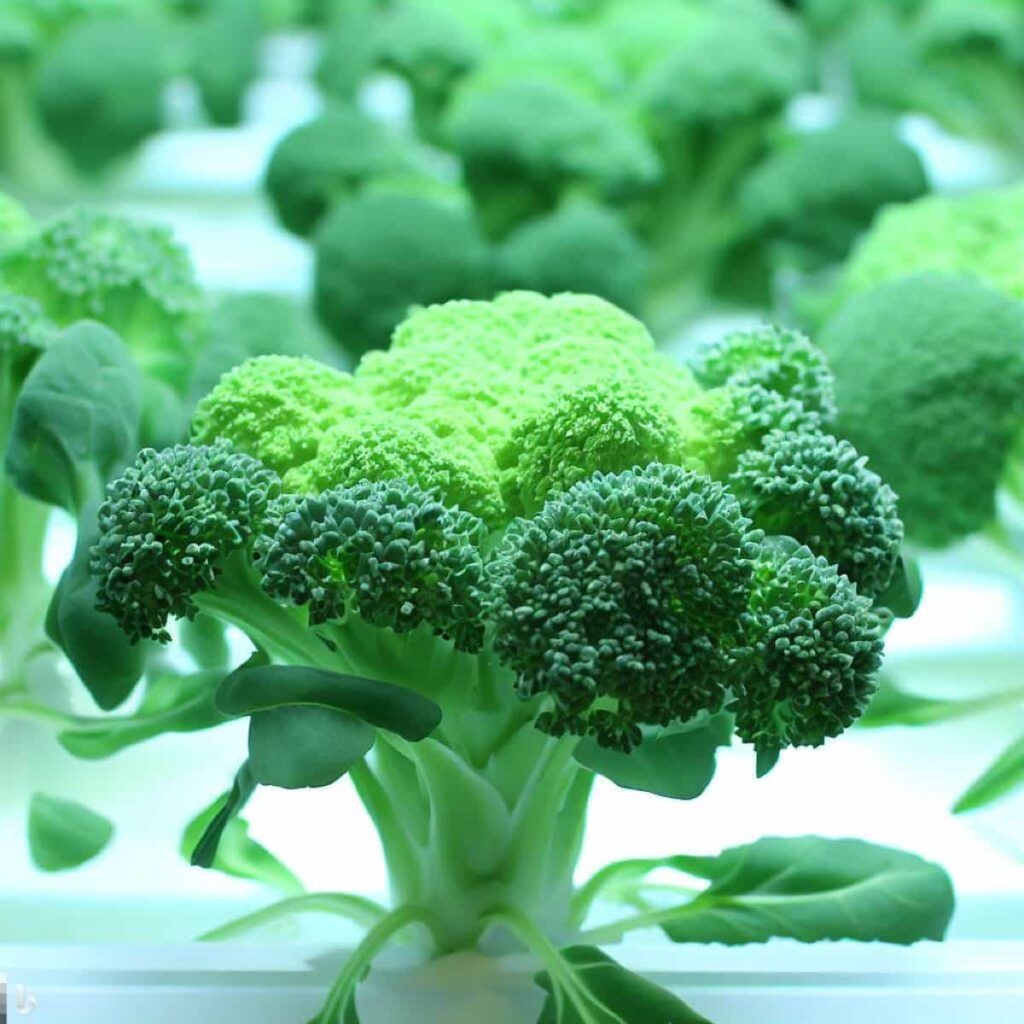
Whether you’re a seasoned hydroponic gardener or just starting, our scientific approach will provide the knowledge you need to cultivate delicious and nutritious Broccoli in your hydroponic system successfully.
How to Grow Broccoli Hydroponically
What is Hydroponic Broccoli Indoors Growing?
Hydroponic Broccoli indoors growing is a cutting-edge method of cultivating Broccoli without soil. In this scientific approach, plants are nurtured in nutrient-rich water solutions. It offers several advantages, such as precise nutrient control and year-round growth. Broccoli thrives in hydroponic systems, producing high yields in limited space.
The key nutrients include nitrogen, phosphorus, and potassium, tailored for optimal growth. LED grow lights simulate natural sunlight, promoting photosynthesis. Hydroponic Broccoli typically matures in 60-90 days, depending on the variety and conditions. This method allows you to enjoy fresh, pesticide-free Broccoli in your indoor garden all year while reducing water usage and environmental impact.
In case you missed it: How to Grow and Care for Broccoli in India: A Step-By-Step Guide to Seed to Harvest
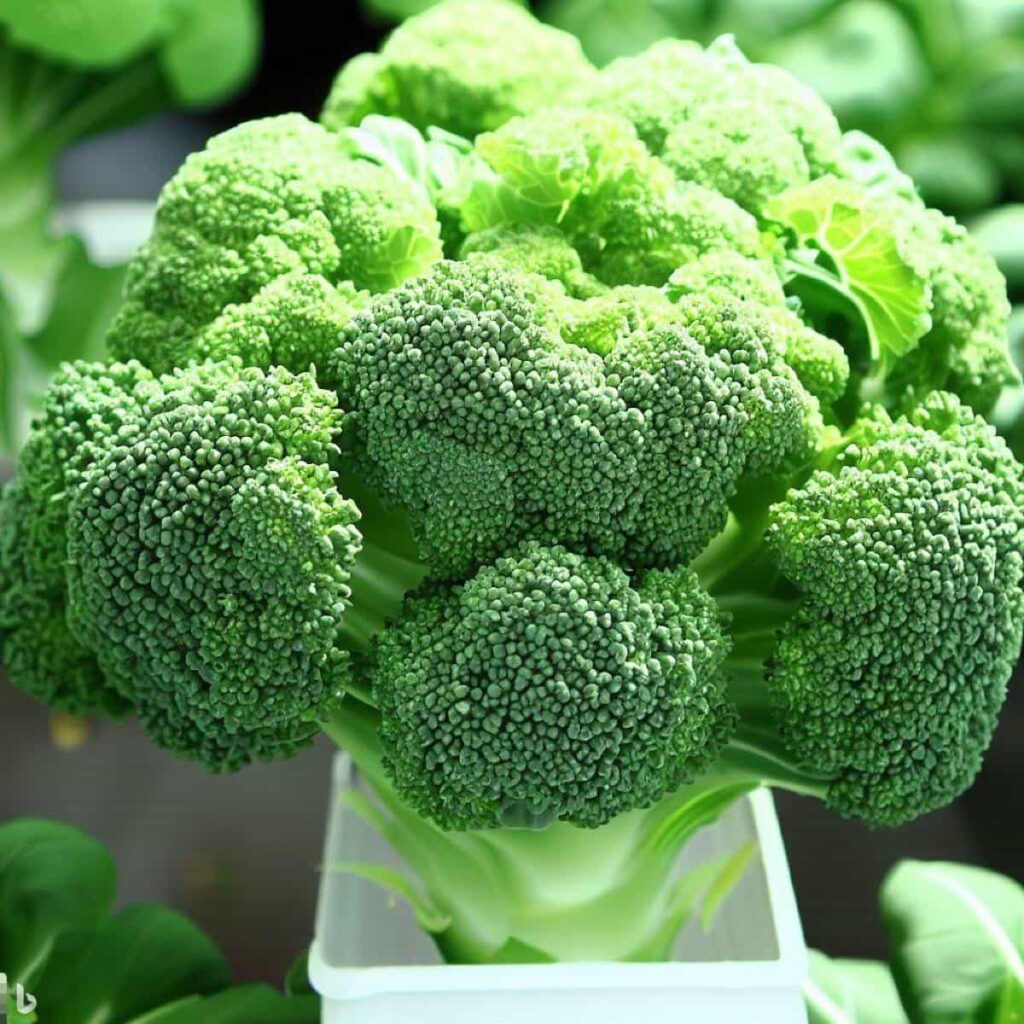
Choosing the Right Hydroponic System for Broccoli
Aeroponics: This innovative system suspends plant roots in the air, delivering a nutrient solution as a fine mist through spray nozzles. The oxygenation and nutrient uptake in aeroponics promotes rapid growth and larger yields. While it’s highly efficient, aeroponics can be complex and is typically preferred by experienced growers seeking maximum plant health and growth rates.
Ebb and Flow (Flood and Drain): Ebb and flow systems offer a balanced approach, maintaining oxygenation and nutrient concentration. A flood table or grow tray holds the plants, with a reservoir below. It’s relatively user-friendly but requires some learning for beginners. With proper setup, it can deliver satisfying results.
Deep Water Culture (DWC): DWC is another suitable option for growing Broccoli. In this system, plant roots are suspended directly in a nutrient solution, eliminating the need for a water pump. Oxygen is provided via an air stone and pump. It’s low-maintenance and offers quicker growth times with fewer moving parts. DWC systems are available in various configurations, including 5-gallon bucket setups, making them accessible to many growers.
Selecting Broccoli Varieties for Hydroponic Growth
Even though Calabrese varieties are popular, you can choose the variety of Broccoli that best suits your preferences and needs. These varieties vary in days until harvest, size, and temperature tolerance but generally thrive in hydroponic setups. Consider exploring options like Arcadia, Blue Wind, and Di Cicco, which are known to perform well in hydroponic environments. This flexibility allows you to cultivate the Broccoli that best suits your hydroponic gardening goals.
In case you missed it: Hydroponic Saffron Farming: Cultivating Premium Saffron through Modern Techniques
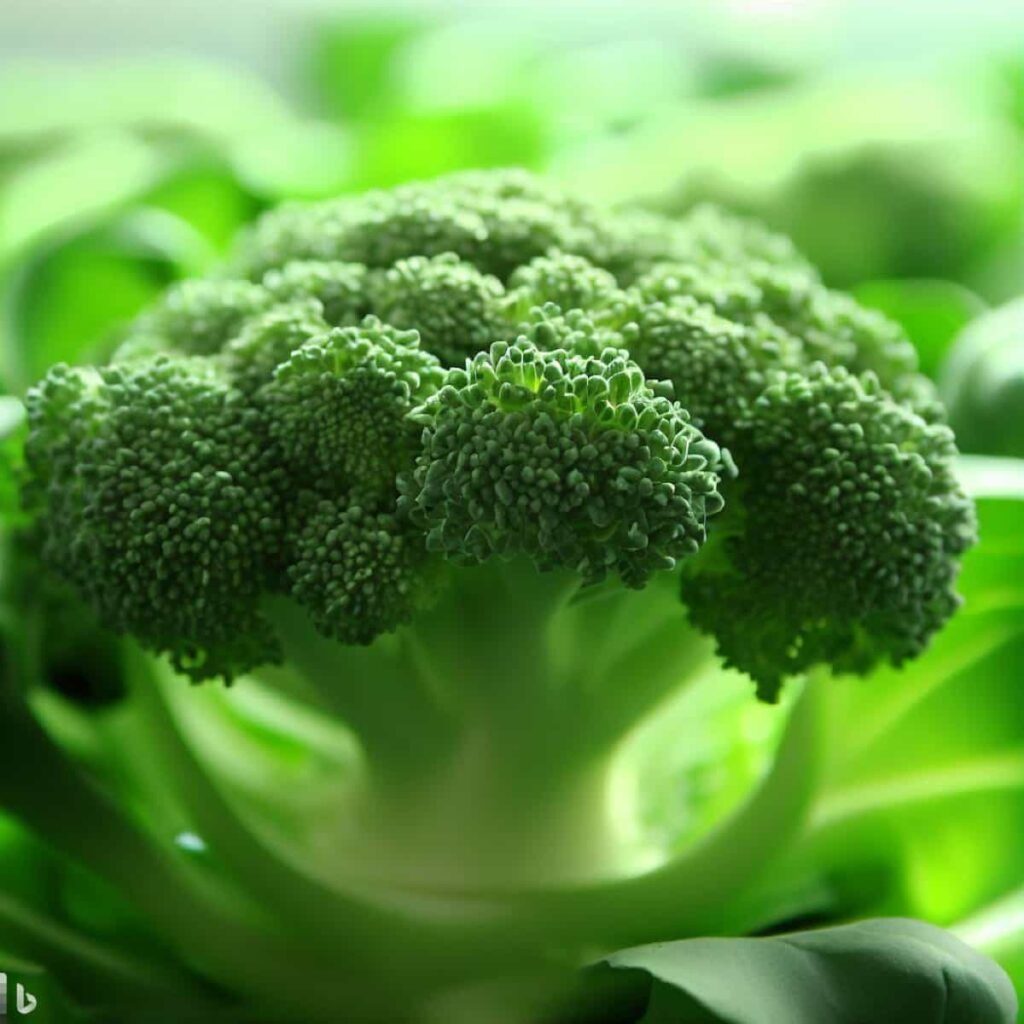
Preparing the Hydroponic Growing Environment for Broccoli
Grow Lights: Broccoli demands ample light, making high-quality LED grow lights a crucial component. These lights provide the necessary light spectrum for plant growth and can be adjusted to cater to different growth stages. Properly positioning the lights to ensure uniform coverage is essential for optimal results.
Growing Medium: Selecting a lightweight, water-retentive growing medium is vital. Common choices for hydroponic Broccoli include Rockwool, coco coir, and perlite. Avoid using soil, as it can impede nutrient and water flow.
Nutrient Solution: A balanced nutrient solution for leafy greens or brassicas is essential. Adhering to the manufacturer’s instructions for mixing and pH adjustment (typically between 5.5 and 6.5) is crucial for healthy growth.
Reservoir and Pump: A reservoir to hold the nutrient solution and a pump for circulation are necessary. Proper sizing of the pump relative to the system’s size ensures consistent nutrient and oxygen supply.
Air Pump and Stone: Oxygen is critical for root health. Incorporate an air pump and stone to aerate the nutrient solution, preventing root rot and supporting vigorous growth.
pH and EC Measurement Tools: Regular pH and electrical conductivity (EC) monitoring is essential. Use meters to maintain the solution within the optimal range for Broccoli. Adjust pH and nutrient levels as needed for a stable environment.
Temperature and Humidity Control: Broccoli thrives in cooler temperatures with moderate humidity. Install thermometers and hygrometers to monitor conditions. Employ fans or ventilation systems to maintain the desired temperature and humidity levels.
Support Structures: As broccoli plants grow, they can become top-heavy. Stakes or trellises are essential to prevent them from collapsing.
Seeds or Seedlings: Begin with high-quality broccoli seeds or seedlings from reputable sources. Transplant them into the hydroponic system once they reach the appropriate size, ensuring proper root embedding and contact with the nutrient solution.
Hydroponic Broccoli Nutrients
Broccoli has different requirements, unlike some plants in the vegetative stage that require ample nitrogen. Excess nitrogen can lead to a “hollow stem,” attracting pests and diseases. Instead, choose a well-balanced, customizable nutrient solution for Broccoli and brassicas. It’s advisable to change the nutrient solution approximately once a week. Broccoli thrives in cooler temperatures, ideally below 70 degrees Fahrenheit, to avoid developing a bitter taste. Hydroponic growers typically maintain temperatures between 55 to 65 degrees.
In case you missed it: Hydroponic Farming in Kenya: Project Report, Cost and Profit Analysis
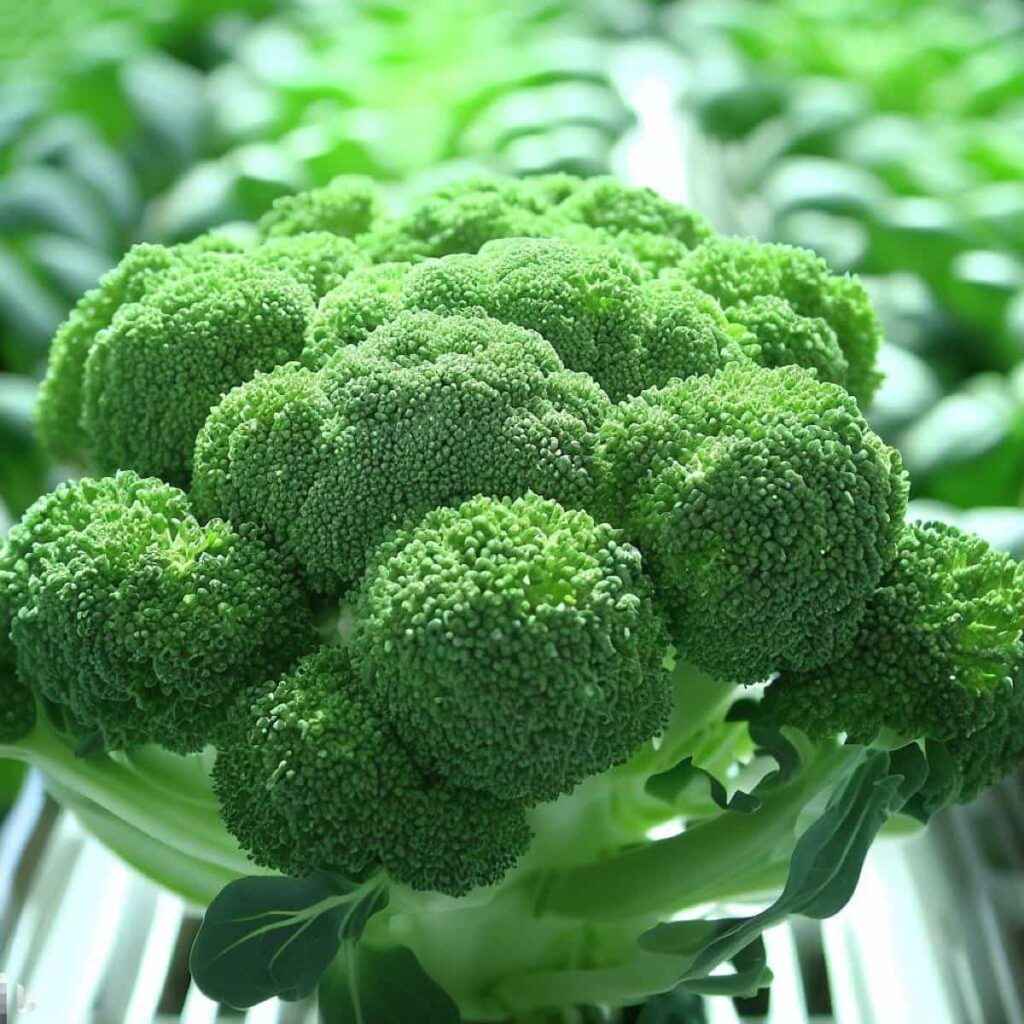
Adequate lighting is essential, with 14 to 16 hours per day under LED or T5 fluorescent lights. Avoid high-intensity discharge (HID) lighting due to excessive heat. Regularly monitor the pH of your water and nutrient solution, aiming for a range of 5.5 to 6.5. While hydroponically grown Broccoli is relatively resistant to pests and diseases, be vigilant for aphids, loopers, cabbage worms, and downy mildew.
Best Growing Conditions for Hydroponic Broccoli Cultivation in Indoor
- Temperature: Broccoli thrives from 50 to 75°F (10-24°C). Maintaining this temperature range is essential for its growth.
- pH Level: The pH level should be maintained within the range of 6.0 to 7.0. This ensures that the nutrient uptake is efficient and that the plants can access essential elements without any nutrient deficiencies or toxicities.
- Light: Broccoli requires 12 to 14 hours of light per day. Adequate lighting is essential for photosynthesis and healthy growth.
- Nutrients: Providing the right nutrients is crucial. Nitrogen, phosphorus, potassium are the basic primary nutrients needed for Broccoli. A balanced nutrient solution tailored to Broccoli’s requirements is essential for optimal development.
- Water: Ensure consistent moisture levels without waterlogging. Wet conditions cause to root rot, while drought stress can hinder growth. Finding the right balance is critical.
- Spacing: Maintain a spacing of 12 to 18 inches (30-45 cm) between broccoli plants to allow for proper air circulation and growth space.
- Growing Time: Depending on the variety and growing conditions, Broccoli typically takes 60 to 100 days to mature.
- Harvest Time: Harvest broccoli when the head is firm and tight, typically reaching about 4 to 7 inches (10-18 cm) in diameter. Harvesting at the right time ensures the best flavor and texture.
Managing Ph Levels in Hydroponic Broccoli Cultivation
Broccoli thrives in a pH range of 6.0 to 7.0, which is crucial for nutrient availability. PH influences the absorption of essential nutrients like nitrogen, phosphorus, and potassium. Too high or too low, nutrient deficiencies or toxicities can occur, stunting growth and causing health issues. Regularly checking the pH level of nutrient solutions is essential to maintaining balance and promoting healthy growth. This delicate pH balance is crucial for hydroponic broccoli care, ensuring a successful harvest of fresh, nutritious greens.
Controlling Temperature and Humidity for Successful Broccoli Growth
Broccoli thrives in a temperature range of 50-75°F (10-24°C), and a cool environment below 70°F is crucial to prevent bitter taste. Ideal hydroponic temperatures are 55-65°F. Light is LED or T5 fluorescent, but avoid HID lighting. Broccoli needs 14-16 hours of light per day. Maintaining moderate humidity levels with proper ventilation and air circulation is beneficial for preventing fungal issues.
In case you missed it: Exploring the Potential of Hydroponic Farming in the Philippines
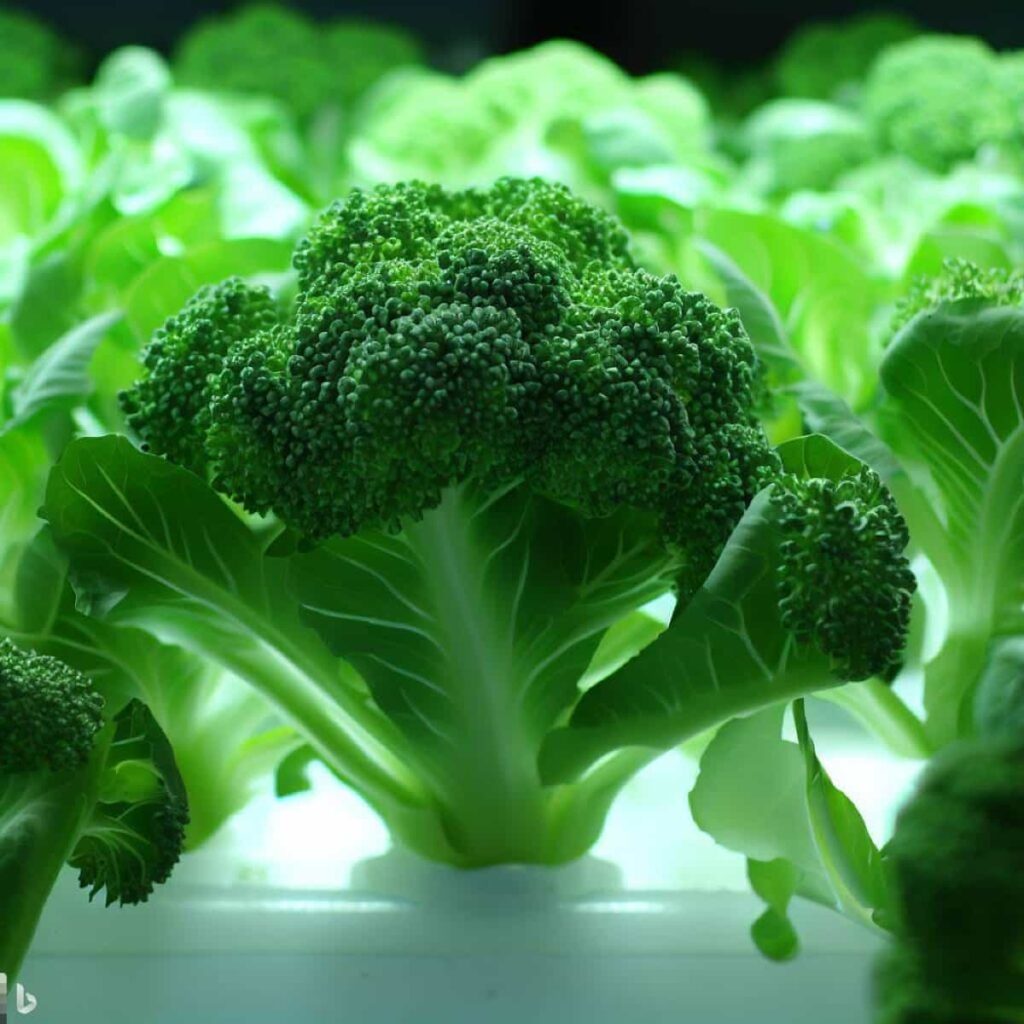
Lighting Requirements for Hydroponic Broccoli Plants
Light Duration: Broccoli plants generally require 12 to 14 hours of light daily. This extended light period mimics the longer daylight hours of spring and summer, encouraging robust vegetative growth.
Light Type: Broccoli can be grown effectively under various types of lighting. LED (Light Emitting Diode) and T5 fluorescent lights are popular choices for hydroponic systems. They emit the appropriate light spectrum for plant growth, including the blue and red wavelengths crucial for photosynthesis.
Light Intensity: The intensity of light is also important. Broccoli benefits from moderate to high light intensity, typically measured in lumens or foot-candles. Ensure the light source is positioned at the correct height to provide even coverage and prevent plants from leggy or stretching toward the light.
Light Spectrum: The light spectrum is crucial for different growth stages. Blue light stimulates vegetative growth, while red light promotes flowering and fruiting. LED lights can be adjusted to provide the ideal spectrum for Broccoli’s specific growth phase.
Special Operation Techniques for Hydroponic Broccoli
- Regularly prune and thin plants by removing lower leaves and side shoots, thin out crowded plants, use trellises or stakes to support heavy heads and maintain consistent light and nutrients.
- Implement a precise nutrient management system, monitoring and adjusting levels regularly.
- Use timers to ensure Broccoli receives the recommended 12-14 hours of light daily, and consider adjustable LED grow lights for different growth stages.
- Maintain temperature within the 50-75°F (10-24°C) range to support growth and control humidity levels to prevent fungal issues.
Hydroponic Broccoli Grow Time
- Germination: Broccoli seeds germinate within a week, producing seedlings.
- Vegetative Growth: The next 4-6 weeks are devoted to vegetative growth, where the plant establishes its leaves and stems.
- Flowering: Around week 6-8, broccoli plants transition to the flowering stage. During this time, a central head begins to form. This stage can vary depending on the specific broccoli variety.
- Head Development: Over the next few weeks, the central head continues to grow, while side shoots may develop.
- Harvest: Harvesting typically occurs when the central head is firm and compact, measuring about 4-7 inches (10-18 cm) in diameter.
In case you missed it: 15 Common Mistakes to Avoid in Hydroponic Farming: Beginner’s Guide
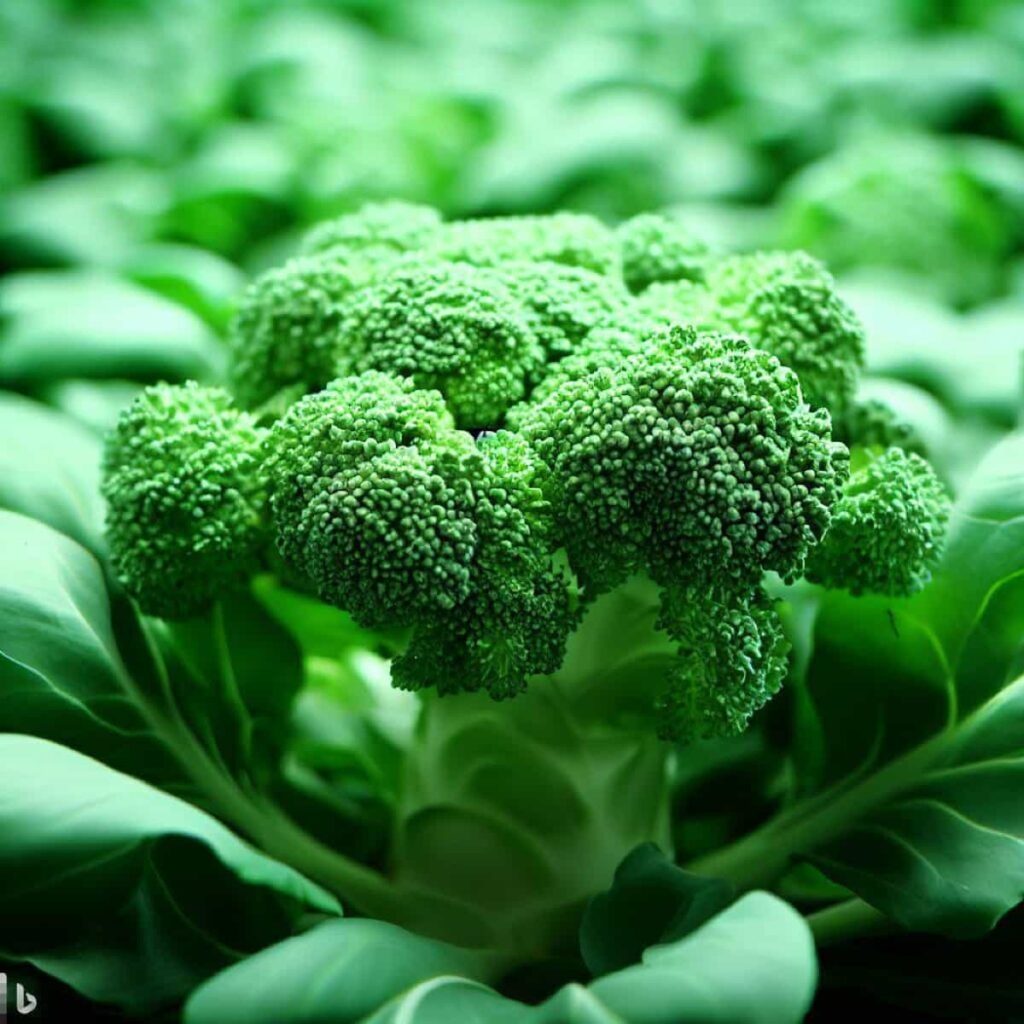
Common Mistakes to Avoid in Growing Hydroponic Broccoli
- Poor pH Management: Remembering pH levels can help nutrient absorption. Maintain a pH of 6.0-7.0 for optimal growth.
- Inadequate Lighting: Broccoli needs 12-14 hours of light daily. More lighting can lead to leggy plants with reduced yields.
- Overcrowding: Plant spacing is crucial (12-18 inches apart). Overcrowding hampers airflow and light distribution, promoting disease.
- Nutrient Imbalance: Ensure a balanced nutrient solution with the right nitrogen, phosphorus, and potassium ratios.
- Inconsistent Watering: Broccoli prefers consistent moisture, not waterlogging. Inconsistent watering can stress the plants.
- Ignoring Temperature: Maintain temperatures between 50-75°F (10-24°C). Extreme cold or heat can stunt growth.
- Skipping Pruning: Failure to prune lower leaves and side shoots diverts energy from the main head, reducing yields.
- Ignoring Humidity: Maintain humidity around 55-65% to prevent fungal issues.
- Inadequate Support: Neglecting support for broccoli heads can result in breakage or toppling.
- Harvesting Late: Harvest when the head is firm and tight (4-7 inches in diameter) to prevent bitterness.
Harvesting and Post-harvest Care of Hydroponically Grown Broccoli
Hydroponic Broccoli is ready for harvest when the central head is fully developed, typically around 80 days after planting. Harvest time may vary depending on the broccoli variety. To maximize yields, consider a continuous harvest approach: cut the stem about four to five inches below the head instead of uprooting the entire plant. This practice encourages the growth of additional shoots, allowing you to harvest more Broccoli over the plant’s life cycle. Repeat this process several times as new shoots develop.
Conclusion
Growing Broccoli hydroponically offers a rewarding and efficient way to cultivate this nutritious vegetable. You can ensure robust broccoli growth by carefully managing nutrients, adhering to the right grow time, and providing suitable lighting. Remember the optimal temperature range, proper spacing, and timely harvesting. Hydroponic Broccoli not only allows for year-round cultivation but also offers the satisfaction of homegrown, fresh Broccoli that is both delicious and healthy.
- Profitable Village Farming Business Ideas in 2024
- High-Yield Aquaculture: Fast-Growing Fish for Farming
- Effective Fish Pond Construction Techniques for Beginners
- Irrigation and Water Management in Pineapple Farming
- Blossom to Harvest: Mastering Flowering and Pollination in Papaya Farming
- Pig Fattening Essentials: From Selection to Sale for Beginners
- Raising Wagyu Cattle: A Complete Guide for Premium Beef Production
- Soil Types and Their Water Holding Capacity
- Optimizing Irrigation Schedules for Coconut Groves for Enhanced Yield
- Espresso Your Garden: Coffee Grounds for Healthier Acid-Loving Plants
- The Best Soil Mix for Snake Plants: How to Mix Your Own Snake Plant Soil
- Green Thumb Success: Expert Tips for Cultivating Greenhouse Beans All Year Round
- Bloom All Year Round: The Ultimate Guide to Indoor Hyacinth Care
- Eco-Friendly Gardening: How to Make Liquid Fertilizer from Kitchen Waste
- Ultimate Guide to Grow Anise in Pots: Explore Seed Propagation to Harvesting
- Guide to Raising Chester White Pigs: Discover Breed Facts to Growth Management
- Mastering the Elegance: The Ultimate Guide to Weeping Cherry Tree Care, Planting, and Maintenance
- Ultimate Guide to Planting Garlic in Grow Bags: Growing Strategies for Beginners
- How to Fix Spider Plant Leaf-Related Problems: Natural and Organic Remedies
- 10 Reasons Why Your Tulsi Plant is Shedding Leaves: Home Remedies and Solutions
- Optimizing Growth and Yield: The Advantages of Palm Bunch Ash Fertilizer
- Utilizing Neem Oil Extract as a Natural Pesticide for Hydrangea
- From Soil to Harvest: Various Ways in Which Farmers Can Use AI Tools
- Steps to Encourage and Induce Citrus Flowers: A Comprehensive Guide
- How to Fix Snake Plant Leaf-Related Issues: Natural and Organic Remedies
- Transform Your Garden into a Fragrant Oasis with Raat Ki Rani (Night Blooming Jasmine)
- Discover the Ideal Chicken Breeds for Philippine Farms
- How to Create a Poultry Egg Farm Business Plan for Profits
- Grow Lemon Cucumbers Like a Pro: Insider Techniques for Bountiful Yields
- Ultimate Guide to Caring for Your Pink Princess Philodendron: Tips for Thriving Variegation
- Areca Nut Profit Per Acre: Calculating Yield and Cost of Cultivation
- How Kaveri Chicken is Becoming a More Profitable Breed in Indian Backyards
- Transform Your Barn: 9 Steps to Convert a Horse Stall into a Chicken Coop
- Exploring Suffolk Sheep Disadvantages with Limitations and Challenges
- Guide to Solving Potted Lemon Tree Problems: How to Revive Lemon Tree in Containers
- Steps to Encourage Female Pumpkin Flowers: Best Strategies for More Flowers and High Yields
